-
 Utagawa Kunisada [歌川 国貞]; a.k.a. Utagawa Toyokuni III [三代歌川豊国] (Japanese, 1786 – 1865). Signed: Toyokuni ga [豊国 画] in a red toshidama cartouche. Publisher: Mikawaya Heiroku [三川屋平六] (Japanese, fl. c. 1848 – 1856); seal: Mihei [三平] (Marks 11-016 | 325a) Block carver: Yokokawa Takejirō [横川竹二郎] (Japanese, fl. 1845 – 1863), seal: 彫竹 – Hori Take. Date seal and aratame censor seal: [辰正] Ansei 3, 1st month (1856). Inscriptions: Right cartouche: Three good fortunes of the present day [当世三福対] (Tosei sambuku tsui) Center cartouche: Ubuge no Kintaro [産毛の金太郎] (うぶげのきんたろう) According to Horst Graebner, the play is Tomigaoka koi no Yamabiraki (or Tomioka Koi no Yamabiraki [富岡戀山開], according to kabuki21.com, common title Ninin Shinbē [二人新兵衛]); Kintarō might be Nakamura Fukusuke I [中村福助], the female role might be Mikuni Kojorō [三国小女郎] (or Mikuni no Kojorō). Nakamura Shikan IV [中村芝翫] (Japanese, 1831 – 1899); other names: Nakamura Fukusuke I, Nakamura Masanosuke I, Nakamura Komasaburō, Nakamura Tamatarō I.
Utagawa Kunisada [歌川 国貞]; a.k.a. Utagawa Toyokuni III [三代歌川豊国] (Japanese, 1786 – 1865). Signed: Toyokuni ga [豊国 画] in a red toshidama cartouche. Publisher: Mikawaya Heiroku [三川屋平六] (Japanese, fl. c. 1848 – 1856); seal: Mihei [三平] (Marks 11-016 | 325a) Block carver: Yokokawa Takejirō [横川竹二郎] (Japanese, fl. 1845 – 1863), seal: 彫竹 – Hori Take. Date seal and aratame censor seal: [辰正] Ansei 3, 1st month (1856). Inscriptions: Right cartouche: Three good fortunes of the present day [当世三福対] (Tosei sambuku tsui) Center cartouche: Ubuge no Kintaro [産毛の金太郎] (うぶげのきんたろう) According to Horst Graebner, the play is Tomigaoka koi no Yamabiraki (or Tomioka Koi no Yamabiraki [富岡戀山開], according to kabuki21.com, common title Ninin Shinbē [二人新兵衛]); Kintarō might be Nakamura Fukusuke I [中村福助], the female role might be Mikuni Kojorō [三国小女郎] (or Mikuni no Kojorō). Nakamura Shikan IV [中村芝翫] (Japanese, 1831 – 1899); other names: Nakamura Fukusuke I, Nakamura Masanosuke I, Nakamura Komasaburō, Nakamura Tamatarō I. -
 Artist: Utagawa Kunisada [歌川 国貞]; a.k.a. Utagawa Toyokuni III [三代歌川豊国] (Japanese, 1786 – 1865). Signed: Toyokuni ga [豊国 画] in a red toshidama cartouche. Publisher: Ibaya Senzaburō [伊場屋仙三郎] (Japanese, fl. C. 1845 – 1847), seal: San [三] (Marks 11-001 | 127c). Block carver: Matsushima Fusajirō [松嶋房次郎] (Japanese, fl. 1843 – 1850); seal [彫工房] – Hori kō Fusa. Double nanushi censor seal: Kunigasa & Watanabe (1849-50). Actor: Ichikawa Danjūrō VII [市川団十郎] (Japanese, 1791 – 1859); other names: Ichikawa Ebizō V [市川海老蔵], Ichikawa Hakuen II, Ichikawa Shinnosuke I. Play: Yukari no Hana Iro mo Yoshiwara [紫花色吉原], performed at the Kawarazaki Theater (Edo) from the 5th day of the 5th lunar month of Kaei 3 (1850) (see Kabuki Playbill at MFA (Boston) № 11.27996).
Artist: Utagawa Kunisada [歌川 国貞]; a.k.a. Utagawa Toyokuni III [三代歌川豊国] (Japanese, 1786 – 1865). Signed: Toyokuni ga [豊国 画] in a red toshidama cartouche. Publisher: Ibaya Senzaburō [伊場屋仙三郎] (Japanese, fl. C. 1845 – 1847), seal: San [三] (Marks 11-001 | 127c). Block carver: Matsushima Fusajirō [松嶋房次郎] (Japanese, fl. 1843 – 1850); seal [彫工房] – Hori kō Fusa. Double nanushi censor seal: Kunigasa & Watanabe (1849-50). Actor: Ichikawa Danjūrō VII [市川団十郎] (Japanese, 1791 – 1859); other names: Ichikawa Ebizō V [市川海老蔵], Ichikawa Hakuen II, Ichikawa Shinnosuke I. Play: Yukari no Hana Iro mo Yoshiwara [紫花色吉原], performed at the Kawarazaki Theater (Edo) from the 5th day of the 5th lunar month of Kaei 3 (1850) (see Kabuki Playbill at MFA (Boston) № 11.27996). Sano Jirōzaemon [佐野次郎左衛門] – provincial commoner who killed a famous Yoshiwara courtesan named ManjiyaYatsuhashi [万字屋 八ツ橋] (on the second sheet of the pair):
Sano Jirōzaemon [佐野次郎左衛門] – provincial commoner who killed a famous Yoshiwara courtesan named ManjiyaYatsuhashi [万字屋 八ツ橋] (on the second sheet of the pair):
Another Kunisada's print with the same characters in the same play and same performance can be seen at MFA (Boston) № 11.40190.
SVJP-0298.2019: Ichikawa Ebizō V as Sano Jirōzaemon.

SVJP-0297.2019: Iwai Kumesaburō III as Manjiya Yatsuhashi
 One more example can be seen at the two upper images in Waseda University Cultural Resources Database, № 006-2707:
One more example can be seen at the two upper images in Waseda University Cultural Resources Database, № 006-2707:

-
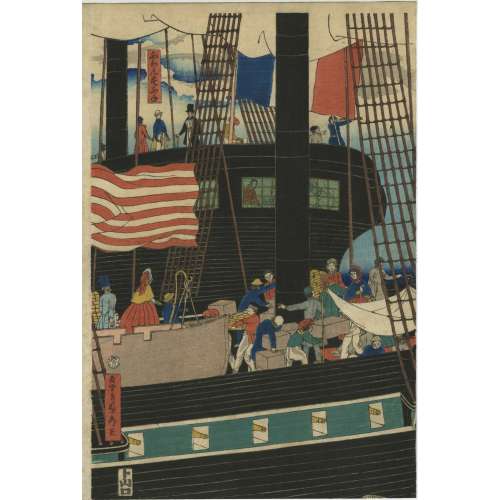 Utagawa Sadahide, a.k.a. Gountei Sadahide (Japanese, 1807 – c. 1878–1879), 五雲亭 貞秀, 歌川 貞秀, Yamaguchiya Tōbei, Yokohama kōeki seiyōjin nimotsu unsō no zu - Western traders loading cargo in Yokohama - 横浜交易西洋人荷物運送之圖, 1861, Woodblock print (nishiki-e); ink and color on paper, Horizontal Ōban Pentaptych: 5 x (37 x 25.5 cm), Alternative title: Picture of Western Traders at Yokohama Transporting Merchandise (Cat. Reisonée: Yokohama ukiyo-e, Yurindo, 1979: №50). Japanese pentaptych print shows an American ship in the harbor at Yokohama, Japan; small boats ferry cargo which is being carried up a gangplank contributing to the bustle of activity on the main deck. April, 1861. SOLD
Utagawa Sadahide, a.k.a. Gountei Sadahide (Japanese, 1807 – c. 1878–1879), 五雲亭 貞秀, 歌川 貞秀, Yamaguchiya Tōbei, Yokohama kōeki seiyōjin nimotsu unsō no zu - Western traders loading cargo in Yokohama - 横浜交易西洋人荷物運送之圖, 1861, Woodblock print (nishiki-e); ink and color on paper, Horizontal Ōban Pentaptych: 5 x (37 x 25.5 cm), Alternative title: Picture of Western Traders at Yokohama Transporting Merchandise (Cat. Reisonée: Yokohama ukiyo-e, Yurindo, 1979: №50). Japanese pentaptych print shows an American ship in the harbor at Yokohama, Japan; small boats ferry cargo which is being carried up a gangplank contributing to the bustle of activity on the main deck. April, 1861. SOLD -
 Artist: Utagawa Kunisada, a.k.a. Toyokuni III (Japanese, 1786 – 1865) [歌川 国貞]. Publisher: Ibaya Senzaburō [伊場屋仙三郎] (Japanese, fl. C. 1845 – 1847). Date aratame seal: Bunsei 12 (1829). Signed: Gototei Kunisada ga [五渡亭国貞画]. Media: Fan print (uchiwa-e), 272 x 235 mm. Actor: Iwai Hanshirō VI (Japanese, 1799 – 1836); other names: Iwai Hanshirō VI, Iwai Kumesaburō II, Iwai Hisajirō I, Baiga [梅我] (poetry name), Shūka (poetry name). The background is Arare-ko-mon [霰小紋] hail pattern. Kabuki actor Iwai Kumesaburō II in the role of An no Heibei [安の平兵衛] in the drama Otokodate Itsutsu Karigane [男作五雁金] (Play, 7 acts. Produced 1742/09). From Lyon collection: The real An no Heibei (ca. 1672-1702): "In a gang with Kaitate no Kichiemon, Hote no Ichiemon, Mippiki Jihei and others as of the Seventh Month of 1697. Attacked people with a sword on the sixth day, Seventh Month, 1699, which he then secreted with Kichiemon. On the evening of the sixth day, Sixth Month, 1701, stabbed Kibei, an employee of Kawachiya Gohei of the residential quarter Kyuhoji, in the side with a dagger. A subsequent police investigation resulted in Heibei's arrest the following day. Beheaded at the execution grounds located at Sennichi Mae on the twenty-sixth day of the Eighth Month, 1702." Note: According to Horst Graebner, the actor's name below the series title in the cartouche is Baiga (梅我), the poetry name of Iwai Kumesaburō II. On the other prints in this series, the actors are also named on the other prints with their poetry names. In the red cartouche at the top left is the series title "Edo no hana – itsutsu Karigane" (江戸の花 五雁金), to be translated as "Flowers of Edo - the five Karigane blood-brothers" (or "the five Karigane gang members"). "Since there was no performance with the Karigane brothers from 1829, these must be mitate prints", states Mr Graebner.
Artist: Utagawa Kunisada, a.k.a. Toyokuni III (Japanese, 1786 – 1865) [歌川 国貞]. Publisher: Ibaya Senzaburō [伊場屋仙三郎] (Japanese, fl. C. 1845 – 1847). Date aratame seal: Bunsei 12 (1829). Signed: Gototei Kunisada ga [五渡亭国貞画]. Media: Fan print (uchiwa-e), 272 x 235 mm. Actor: Iwai Hanshirō VI (Japanese, 1799 – 1836); other names: Iwai Hanshirō VI, Iwai Kumesaburō II, Iwai Hisajirō I, Baiga [梅我] (poetry name), Shūka (poetry name). The background is Arare-ko-mon [霰小紋] hail pattern. Kabuki actor Iwai Kumesaburō II in the role of An no Heibei [安の平兵衛] in the drama Otokodate Itsutsu Karigane [男作五雁金] (Play, 7 acts. Produced 1742/09). From Lyon collection: The real An no Heibei (ca. 1672-1702): "In a gang with Kaitate no Kichiemon, Hote no Ichiemon, Mippiki Jihei and others as of the Seventh Month of 1697. Attacked people with a sword on the sixth day, Seventh Month, 1699, which he then secreted with Kichiemon. On the evening of the sixth day, Sixth Month, 1701, stabbed Kibei, an employee of Kawachiya Gohei of the residential quarter Kyuhoji, in the side with a dagger. A subsequent police investigation resulted in Heibei's arrest the following day. Beheaded at the execution grounds located at Sennichi Mae on the twenty-sixth day of the Eighth Month, 1702." Note: According to Horst Graebner, the actor's name below the series title in the cartouche is Baiga (梅我), the poetry name of Iwai Kumesaburō II. On the other prints in this series, the actors are also named on the other prints with their poetry names. In the red cartouche at the top left is the series title "Edo no hana – itsutsu Karigane" (江戸の花 五雁金), to be translated as "Flowers of Edo - the five Karigane blood-brothers" (or "the five Karigane gang members"). "Since there was no performance with the Karigane brothers from 1829, these must be mitate prints", states Mr Graebner. -
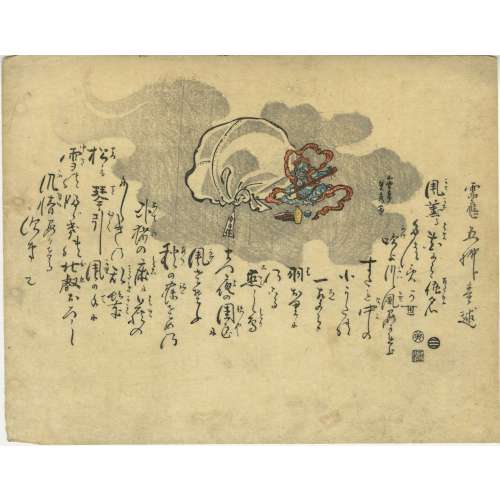 Artist: Utagawa Sadahide [歌川 貞秀] (Japanese, 1807 – c. 1878-9). Publisher: Ibaya Senzaburō [伊場屋仙三郎] (Japanese, c. 1815 – 1869). Date-kiwame seal: 1831 (Tenpō 2). Size: Uchiwa-e, 298 x 232 mm. Signed: 五雲亭 貞秀 (Gountei Sadahide) A pair of uncut fan prints with the god of wind and the god of thunder meant to be pasted on two sides of a uchiwa fan. This is an allusion to the famous painting Wind God & Thunder God [Fujin Raijin, 風神雷神図] by Ogata Korin [尾形光琳] (1658 - 1716).
Artist: Utagawa Sadahide [歌川 貞秀] (Japanese, 1807 – c. 1878-9). Publisher: Ibaya Senzaburō [伊場屋仙三郎] (Japanese, c. 1815 – 1869). Date-kiwame seal: 1831 (Tenpō 2). Size: Uchiwa-e, 298 x 232 mm. Signed: 五雲亭 貞秀 (Gountei Sadahide) A pair of uncut fan prints with the god of wind and the god of thunder meant to be pasted on two sides of a uchiwa fan. This is an allusion to the famous painting Wind God & Thunder God [Fujin Raijin, 風神雷神図] by Ogata Korin [尾形光琳] (1658 - 1716). And the earlier versions of the same by Tawaraya Sotatsu [俵屋宗達] (1570-1643).
And the earlier versions of the same by Tawaraya Sotatsu [俵屋宗達] (1570-1643).
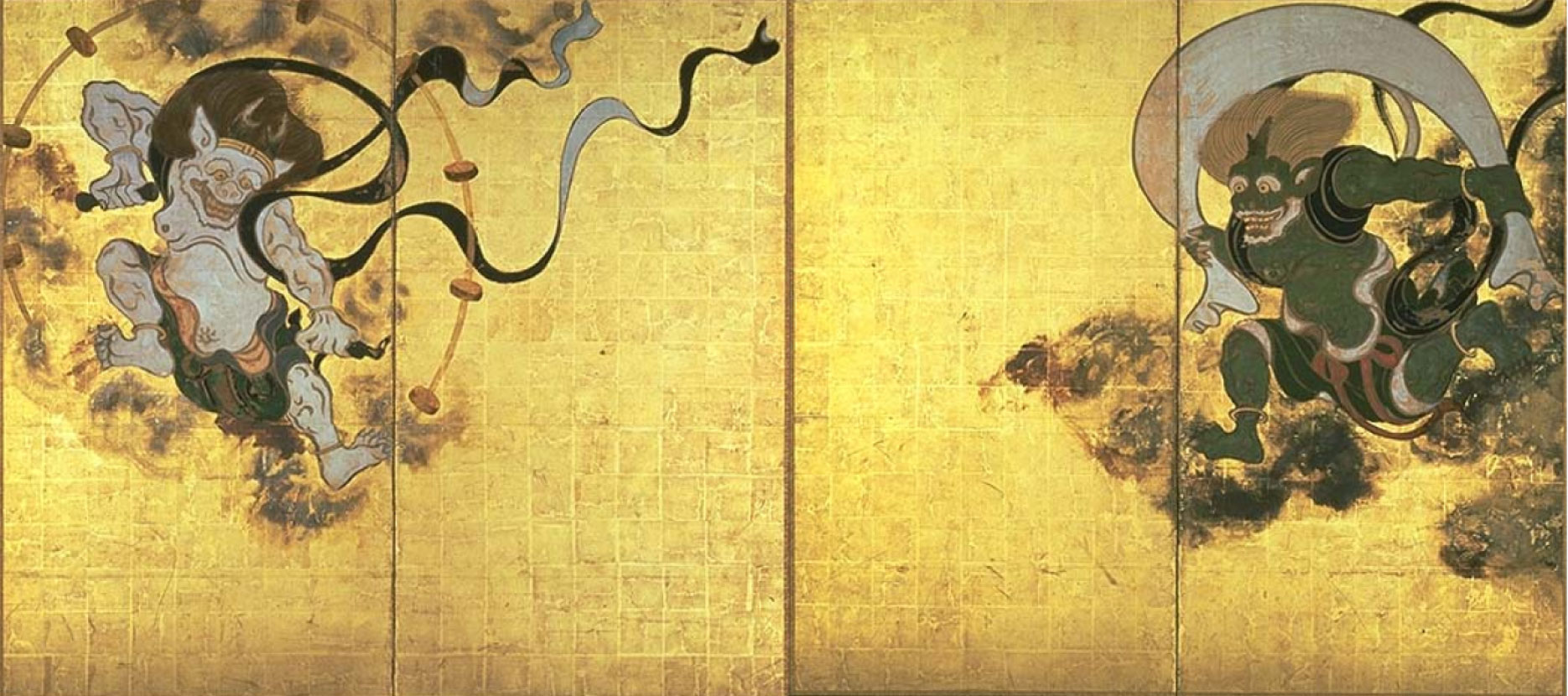
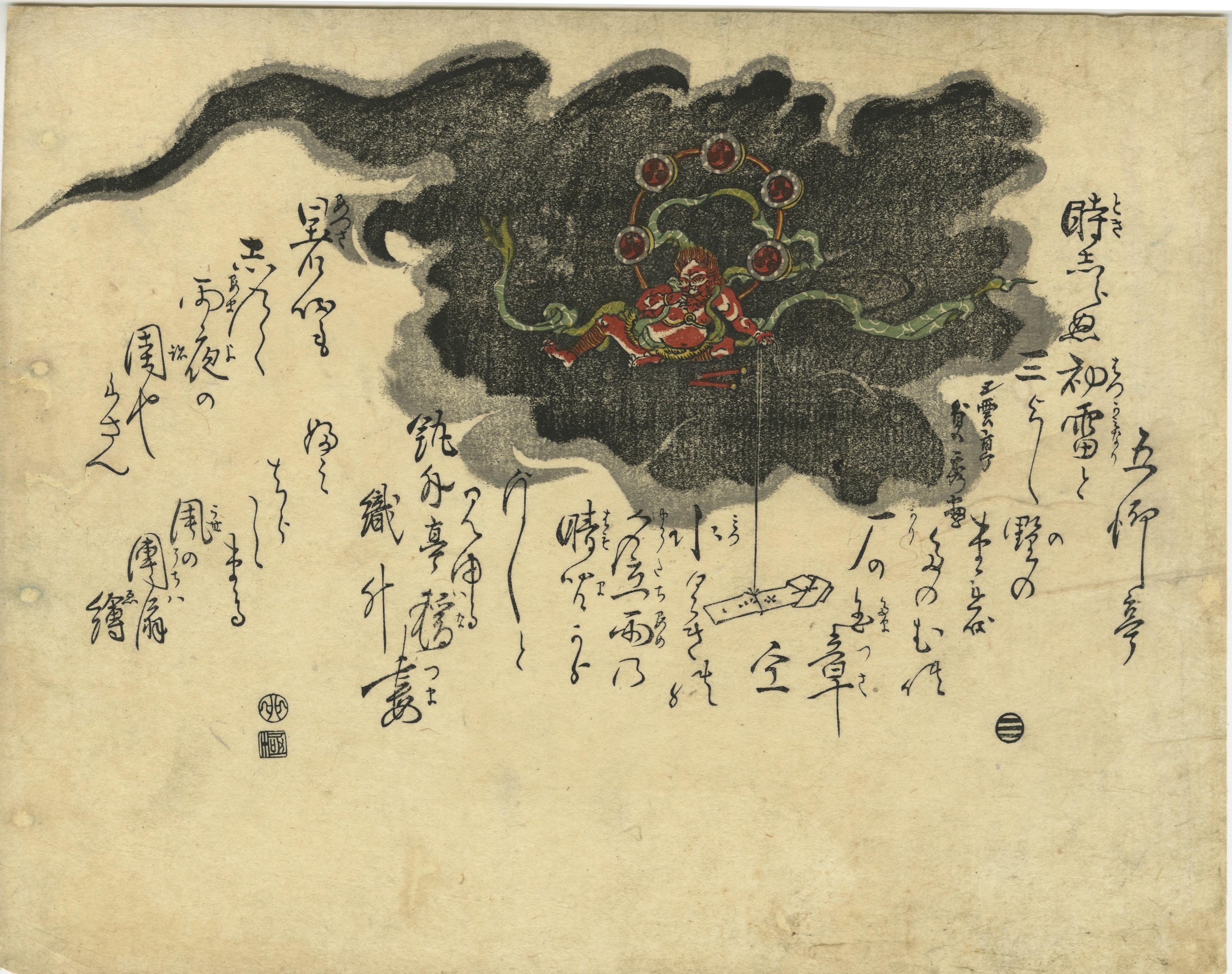
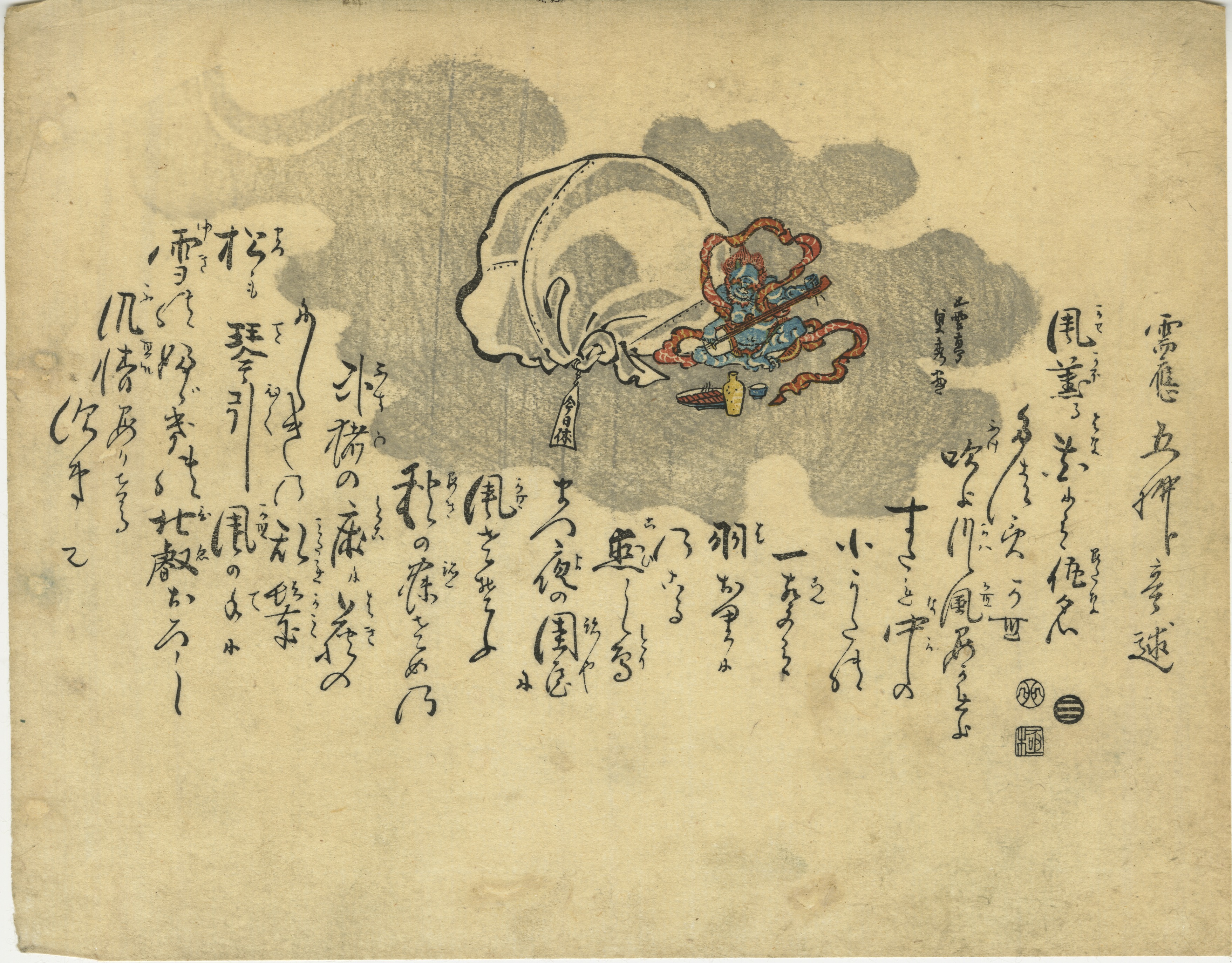
-
 Uncut fan print (uchiwa-e) with the design of kabuki actor Nakamura Utaemon IV who held the name of Nakamura Shikan II from the 11th lunar month of 1825 to the 12th lunar month of 1835, dressed in a checkered kimono, holding a pipe and surrounded by flying fireflies. Character: Nakamura Utaemon IV [中村歌右衛門] (Japanese, 1796 – 1852); other names: Nakamura Shikan II, Nakamura Tsurusuke I, Nakamura Tōtarō. Series title: Catching fireflies in the floating world [浮世蛍狩] (Ukiyo hotarugari). Artist: Utagawa Kunisada [歌川 国貞], a.k.a. Toyokuni III (Japanese, 1786 – 1865). Signed: Kōchōrō Kunisada ga [香蝶楼国貞画] in a red cartouche. Publisher: Ibaya Kyubei [伊場屋 久兵衛] (Japanese, fl. 1804 – 1851); seal: modified Marks 19-009 | 126d. Censor's seal: Kiwame Date seal: Tenpō 2 (1831). Ref: Kunisada.de, N58. A look-alike yearlier Kunisada's design can be found at kunisada.de, ref. # N120-Z0172-410:
Uncut fan print (uchiwa-e) with the design of kabuki actor Nakamura Utaemon IV who held the name of Nakamura Shikan II from the 11th lunar month of 1825 to the 12th lunar month of 1835, dressed in a checkered kimono, holding a pipe and surrounded by flying fireflies. Character: Nakamura Utaemon IV [中村歌右衛門] (Japanese, 1796 – 1852); other names: Nakamura Shikan II, Nakamura Tsurusuke I, Nakamura Tōtarō. Series title: Catching fireflies in the floating world [浮世蛍狩] (Ukiyo hotarugari). Artist: Utagawa Kunisada [歌川 国貞], a.k.a. Toyokuni III (Japanese, 1786 – 1865). Signed: Kōchōrō Kunisada ga [香蝶楼国貞画] in a red cartouche. Publisher: Ibaya Kyubei [伊場屋 久兵衛] (Japanese, fl. 1804 – 1851); seal: modified Marks 19-009 | 126d. Censor's seal: Kiwame Date seal: Tenpō 2 (1831). Ref: Kunisada.de, N58. A look-alike yearlier Kunisada's design can be found at kunisada.de, ref. # N120-Z0172-410:
Actor Onoe Baikō, artist Kunisada, publisher Ibaya Kyūbei, c. 1820.
-
 Artist: Utagawa Kunisada [歌川 国貞] a.k.a. Utagawa Toyokuni III [三代歌川豊国] (Japanese, 1786 – 1865). Signed: Toyokuni ga [豊国 画] in a red toshidama cartouche. Publisher: Ibaya Senzaburō [伊場屋仙三郎] (Japanese, c. 1815 – 1869). Double nanushi censor seals: Hama & Magome, Kaei 2-5 (1849 – 1852). An uncut fan print (uchiwa-e, 220 x 292 mm) depicts a beautiful woman sitting on a balcony overlooking a bay and reading a book. Above the book, there is an obi with a pattern of stripes or modified key fret motif, with lettering that reads: 菅原島 [Sugawara-jima] and 美立 [mitate]. The lettering and the blossoming plum branch next to the obi provide an allusion to Sugawara no Michizane [菅原 道真/菅原 道眞] (Japanese, 845 – 903) - a prominent scholar and poet of Heian period exiled from Kyoto to the island of Kyushu as a result of another courtier's slander. A legend says that his beloved plum tree was so fond of its master that it flew to Kyushu with Sugawara. The Davis Museum at Wellesley College describes the print as belonging to the series A Parody of Sugawara Stripe Patterns (Mitate Sugawara-jima). To make the fact of an allusion transparent, Kunisada had changed the usual way of writing "Sugawara stripes" from 菅原縞 to 菅原島 and "mitate" from 見立 to 美立. An unusual spelling was also used to provide additional information to the reader in other cultures. E.g. during the Prohibition Era, the West Coast United States speakeasy bars and bordellos misspelt the items on a menu ("scollops") or in a neon sign ("Martuni's") to tell: here we have more pleasures for you than you may have expected. After Tenpō reforms, the printing of bijin-ga (美人画, "picture of beautiful woman") images was restricted. Our print disguises a typical bijin-ga as an advertisement of an obi (帯, a kimono sash) fabric pattern. "The market of portraits was satisfied and the authorities fooled" [Rebecca Salter. Japanese popular prints. — Honolulu: University of Hawaii Press, 2006].
Artist: Utagawa Kunisada [歌川 国貞] a.k.a. Utagawa Toyokuni III [三代歌川豊国] (Japanese, 1786 – 1865). Signed: Toyokuni ga [豊国 画] in a red toshidama cartouche. Publisher: Ibaya Senzaburō [伊場屋仙三郎] (Japanese, c. 1815 – 1869). Double nanushi censor seals: Hama & Magome, Kaei 2-5 (1849 – 1852). An uncut fan print (uchiwa-e, 220 x 292 mm) depicts a beautiful woman sitting on a balcony overlooking a bay and reading a book. Above the book, there is an obi with a pattern of stripes or modified key fret motif, with lettering that reads: 菅原島 [Sugawara-jima] and 美立 [mitate]. The lettering and the blossoming plum branch next to the obi provide an allusion to Sugawara no Michizane [菅原 道真/菅原 道眞] (Japanese, 845 – 903) - a prominent scholar and poet of Heian period exiled from Kyoto to the island of Kyushu as a result of another courtier's slander. A legend says that his beloved plum tree was so fond of its master that it flew to Kyushu with Sugawara. The Davis Museum at Wellesley College describes the print as belonging to the series A Parody of Sugawara Stripe Patterns (Mitate Sugawara-jima). To make the fact of an allusion transparent, Kunisada had changed the usual way of writing "Sugawara stripes" from 菅原縞 to 菅原島 and "mitate" from 見立 to 美立. An unusual spelling was also used to provide additional information to the reader in other cultures. E.g. during the Prohibition Era, the West Coast United States speakeasy bars and bordellos misspelt the items on a menu ("scollops") or in a neon sign ("Martuni's") to tell: here we have more pleasures for you than you may have expected. After Tenpō reforms, the printing of bijin-ga (美人画, "picture of beautiful woman") images was restricted. Our print disguises a typical bijin-ga as an advertisement of an obi (帯, a kimono sash) fabric pattern. "The market of portraits was satisfied and the authorities fooled" [Rebecca Salter. Japanese popular prints. — Honolulu: University of Hawaii Press, 2006]. -
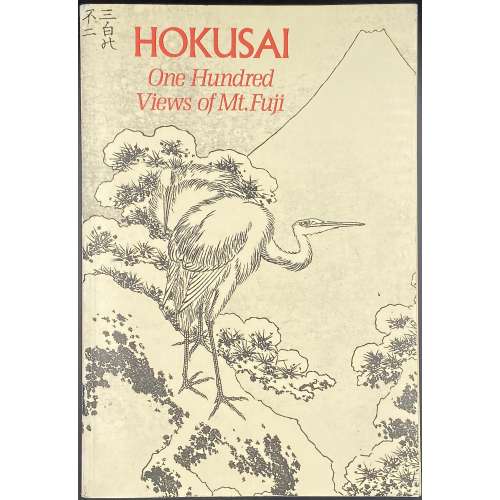 Softcover, 24 x 16.5 cm, publisher's pictorial wrappers, lettering to spine, pp.: [6] 7-224. Full reproduction of Katsushika Hokusai's [葛飾 北斎] (Japanese, 1760 – 1849) series of three illustrated books [絵本, e-hon] One Hundred Views of Mount Fuji [富嶽百景, Fugaku hyakkei], published in Japan in 1834-1849, with commentaries.
Softcover, 24 x 16.5 cm, publisher's pictorial wrappers, lettering to spine, pp.: [6] 7-224. Full reproduction of Katsushika Hokusai's [葛飾 北斎] (Japanese, 1760 – 1849) series of three illustrated books [絵本, e-hon] One Hundred Views of Mount Fuji [富嶽百景, Fugaku hyakkei], published in Japan in 1834-1849, with commentaries. -
 Artist: Utagawa Kunisada [歌川 国貞] a.k.a. Utagawa Toyokuni III [三代 歌川 豊国] (Japanese, 1786 – 1865). Signed: Kōchōrō Kunisada ga [香蝶楼国貞画] in a double-gourd cartouche. Iseya Sōemon [伊勢屋惣右衛門] (Japanese, 1776 – 1862); seal: Ue [上] (Marks 02-041 | 156a). Inscription in the red stripe: Five types of haiku in shōfū style [俳諧五流蕉風] (Haikai gōryū shōfū). Censor's seal: Watari [渡] (Watanabe Shōemon), VI/1842–V ic/1846. Media: Fan print [団扇絵] (Uchiwa-e); size: 225 x 292 mm. An uncut fan print depicts a young woman with an insect (firefly) cage in her left hand. Her striped kimono is adorned with the design of white, grey and blue cherry blossoms. Two of the Seven Grasses of Autumn [秋の七草] (aki no nanakusa), namely Platycodon grandiflorus (kikyō) [桔梗] a.k.a. Chinese bellflower (or balloon flower) and Patrinia scabiosifolia (ominaeshi) [女郎花] a. k.a. Eastern (or Golden) Valerian, are seen on her right-hand side.
Artist: Utagawa Kunisada [歌川 国貞] a.k.a. Utagawa Toyokuni III [三代 歌川 豊国] (Japanese, 1786 – 1865). Signed: Kōchōrō Kunisada ga [香蝶楼国貞画] in a double-gourd cartouche. Iseya Sōemon [伊勢屋惣右衛門] (Japanese, 1776 – 1862); seal: Ue [上] (Marks 02-041 | 156a). Inscription in the red stripe: Five types of haiku in shōfū style [俳諧五流蕉風] (Haikai gōryū shōfū). Censor's seal: Watari [渡] (Watanabe Shōemon), VI/1842–V ic/1846. Media: Fan print [団扇絵] (Uchiwa-e); size: 225 x 292 mm. An uncut fan print depicts a young woman with an insect (firefly) cage in her left hand. Her striped kimono is adorned with the design of white, grey and blue cherry blossoms. Two of the Seven Grasses of Autumn [秋の七草] (aki no nanakusa), namely Platycodon grandiflorus (kikyō) [桔梗] a.k.a. Chinese bellflower (or balloon flower) and Patrinia scabiosifolia (ominaeshi) [女郎花] a. k.a. Eastern (or Golden) Valerian, are seen on her right-hand side. -
 Artist: Utagawa Kunisada [歌川 国貞] a.k.a. Utagawa Toyokuni III [三代 歌川 豊国] (Japanese, 1786 – 1865). An untrimmed fan print titled Fuji Tsukuba aiaigasa, shows the actors Ichikawa Ebizo V [市川海老蔵] and the onnagata actor Iwai Shijaku I [岩井紫若] sharing an umbrella against the wind. Tsukuba, about 50 kilometres from Edo, was an area where both Fuji and Mount Tsukuba could be viewed together. Mount Fuji being the female and Mount Tsukuba the male. An aizuri-e background (common to all the designs in this set). A play on images and words. Actors: Ichikawa Danjūrō VII [市川団十郎] (Japanese, 1791 – 1859); other names: Ichikawa Ebizō V [市川海老蔵], Ichikawa Hakuen II, Ichikawa Shinnosuke I. Iwai Matsunosuke I [岩井松之助] (Japanese, 1804 – 1845); other names: Iwai Hanshirō VII, Iwai Shijaku I [岩井紫若], Iwai Komurasaki I. Publisher: Ibaya Senzaburo [伊場屋仙三郎] (Japanese, fl. c. 1845 – 1847). The publisher’s seal is on the umbrella. Date: circa 1832. Signed: Kōchōrō Kunisada ga in a red double-gourd cartouche. From the series of fan prints:
Artist: Utagawa Kunisada [歌川 国貞] a.k.a. Utagawa Toyokuni III [三代 歌川 豊国] (Japanese, 1786 – 1865). An untrimmed fan print titled Fuji Tsukuba aiaigasa, shows the actors Ichikawa Ebizo V [市川海老蔵] and the onnagata actor Iwai Shijaku I [岩井紫若] sharing an umbrella against the wind. Tsukuba, about 50 kilometres from Edo, was an area where both Fuji and Mount Tsukuba could be viewed together. Mount Fuji being the female and Mount Tsukuba the male. An aizuri-e background (common to all the designs in this set). A play on images and words. Actors: Ichikawa Danjūrō VII [市川団十郎] (Japanese, 1791 – 1859); other names: Ichikawa Ebizō V [市川海老蔵], Ichikawa Hakuen II, Ichikawa Shinnosuke I. Iwai Matsunosuke I [岩井松之助] (Japanese, 1804 – 1845); other names: Iwai Hanshirō VII, Iwai Shijaku I [岩井紫若], Iwai Komurasaki I. Publisher: Ibaya Senzaburo [伊場屋仙三郎] (Japanese, fl. c. 1845 – 1847). The publisher’s seal is on the umbrella. Date: circa 1832. Signed: Kōchōrō Kunisada ga in a red double-gourd cartouche. From the series of fan prints:
Two more prints from the series 'Fuji and Tsukuba sharing an umbrella' (Fuji Tsukuba aiaigasa), not in this Collection:
SVJP-0341.2021

Kabuki actors Onoe Kikugorō III and Iwai Kumesaburo II. Year: c. 1832; Publisher: No seal; Signed: Kōchōrō Kunisada ga From Kunisada Project. 
Kabuki actors Bandō Minosuke II and Iwai Shijaku I. Year: c. 1832; Publisher: No seal; Signed: Kōchōrō Kunisada ga From Kunisada Project. -
 Artist: Utagawa Kunisada [歌川 国貞], a.k.a. Utagawa Toyokuni III [三代 歌川 豊国] (Japanese, 1786 – 1865). An untrimmed fan print titled Fuji Tsukuba aiaigasa, shows the actors Nakamura Shikan II [二代目中村芝翫] and the onnagata actor Iwai Kumesaburō II [岩井粂三郎] sharing an umbrella against the snow. Tsukuba, about 50 kilometres from Edo, was an area where both Fuji and Mount Tsukuba could be viewed together. Mount Fuji being the female and Mount Tsukuba the male. An aizuri-e background (common to all the designs in this set). A play on images and words. Actors: Nakamura Utaemon IV [中村歌右衛門] (Japanese, 1796 – 1852); other names: Nakamura Shikan II [二代目中村芝翫], Nakamura Tsurusuke I, Nakamura Tōtarō. Iwai Hanshirō VI [[岩井半四郎] (Japanese, 1799 – 1836); other names: Iwai Hanshirō VI, Iwai Kumesaburō II [岩井粂三郎], Iwai Hisajirō I, Baiga (poetry name), Shūka (poetry name). Publisher: Ibaya Senzaburo [伊場屋仙三郎] (Japanese, fl. c. 1845 – 1847). Date: circa 1832. Signed: Kōchōrō Kunisada ga in a red double-gourd cartouche. From the series of fan prints:
Artist: Utagawa Kunisada [歌川 国貞], a.k.a. Utagawa Toyokuni III [三代 歌川 豊国] (Japanese, 1786 – 1865). An untrimmed fan print titled Fuji Tsukuba aiaigasa, shows the actors Nakamura Shikan II [二代目中村芝翫] and the onnagata actor Iwai Kumesaburō II [岩井粂三郎] sharing an umbrella against the snow. Tsukuba, about 50 kilometres from Edo, was an area where both Fuji and Mount Tsukuba could be viewed together. Mount Fuji being the female and Mount Tsukuba the male. An aizuri-e background (common to all the designs in this set). A play on images and words. Actors: Nakamura Utaemon IV [中村歌右衛門] (Japanese, 1796 – 1852); other names: Nakamura Shikan II [二代目中村芝翫], Nakamura Tsurusuke I, Nakamura Tōtarō. Iwai Hanshirō VI [[岩井半四郎] (Japanese, 1799 – 1836); other names: Iwai Hanshirō VI, Iwai Kumesaburō II [岩井粂三郎], Iwai Hisajirō I, Baiga (poetry name), Shūka (poetry name). Publisher: Ibaya Senzaburo [伊場屋仙三郎] (Japanese, fl. c. 1845 – 1847). Date: circa 1832. Signed: Kōchōrō Kunisada ga in a red double-gourd cartouche. From the series of fan prints:
Two more prints from the series 'Fuji and Tsukuba sharing an umbrella' (Fuji Tsukuba aiaigasa), not in this Collection:
SVJP-0342.2021

Kabuki actors Onoe Kikugorō III and Iwai Kumesaburo II. Year: c. 1832; Publisher: No seal; Signed: Kōchōrō Kunisada ga From Kunisada Project. 
Kabuki actors Bandō Minosuke II and Iwai Shijaku I. Year: c. 1832; Publisher: No seal; Signed: Kōchōrō Kunisada ga From Kunisada Project. -
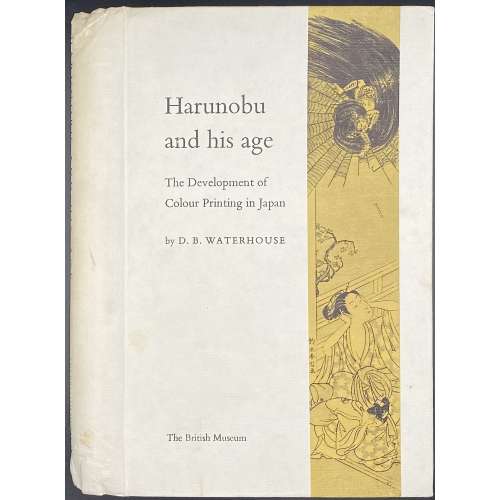
Pictorial cloth boards, spiral-bound, pp.: 3 leaves: h.t., frontis., t.p., 1-326; 123 black & white plates within the pagination.
-
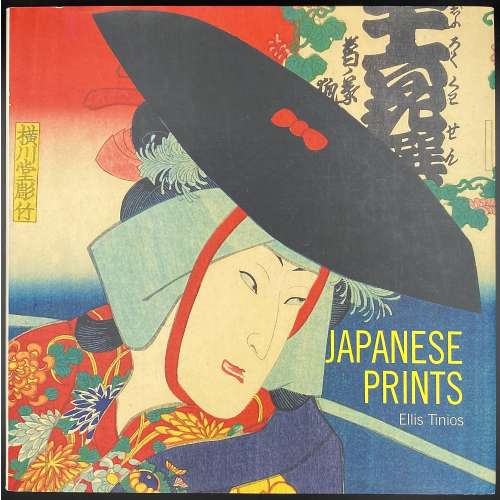 Hardcover, 23.5 x 23.5 cm, publisher's navy cloth, gilt-stamped lettering to spine, pictorial DJ; pp.: [1-6] 7-143 [144 blank].
Hardcover, 23.5 x 23.5 cm, publisher's navy cloth, gilt-stamped lettering to spine, pictorial DJ; pp.: [1-6] 7-143 [144 blank].Japanese woodblock prints of the Edo period (1615-1868) were the products of a highly commercialised and competitive publishing industry. Their content was inspired by the vibrant popular culture that flourished in Edo (Tokyo). At any given time scores of publishers competed for the services of the leading artists of the day. Publishers and artists displayed tremendous ingenuity in finding ways to sustain demand for prints and to circumvent the restrictions placed on the industry through government censorship. Although Japanese prints have long been appreciated in the West for their graphic qualities, their content has not always been fully understood. This book draws on recent scholarship that makes possible a more subtle appreciation of the imagery encountered in the prints and how they would have been read when first made. Through stunning new photography of both well-known and rarely published works in the collection of the British Museum, including many recent acquisitions, the author explores how and why such prints were made, providing a fascinating introduction to a much-loved but little-understood art form.
-
 Hardcover, 30 x 26 cm, publisher's pictorial boards, pp.: [1-5] 6-168, il.
Hardcover, 30 x 26 cm, publisher's pictorial boards, pp.: [1-5] 6-168, il.Published to accompany the recent successful exhibition at the Museu Picasso, Barcelona, this book sheds new light on Picasso's work - his connection with Japanese art. It is illustrated with images
-
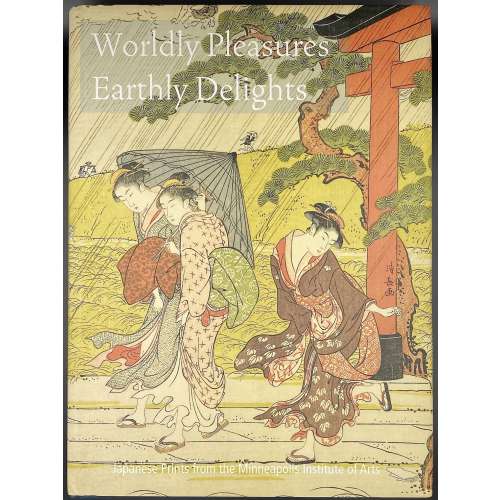 Hardcover, 32 x 23.5 cm, publisher's blue cloth, blind-stamped to cover, gilt lettering to spine, pictorial DJ; pp.: [1-6] 7-375 [376 blank], ill.
Hardcover, 32 x 23.5 cm, publisher's blue cloth, blind-stamped to cover, gilt lettering to spine, pictorial DJ; pp.: [1-6] 7-375 [376 blank], ill.This catalogue features the top ten percent of the collection ... presented in an exhibition ['Great ukiyo-e masters : common pleasures, uncommon prints : Japanese woodcuts from the Minneapolis Institute of Arts', sponsored by Asano Laboratories] that opened in Tokyo at the Shoto Museum of Art on October 2, 2007, and traveled to the Nara Prefectural Museum of Art and the Sanritz Hattori Museum of Arts"--Foreword. "This [2011] publication ... coincides with a special exhibition, 'Edo Pop: Japanese Master Prints from the Minneapolis Institute of Arts' (October 16, 2011, through January 8, 2012), which will [also] be shown at the High Museum of Art in Atlanta ..."--Foreword. "With contributions by Shūgō Asano, Akane Fujisawa, Murasaki Fujisawa, Yuriko Iwakiri, Yōsuke Katō, Junko Mutō, Noriko Yamamoto. Contents: Foreword / Kaywin Feldman Acknowledgments / Matthew Welch, Yuiko Kimura-Tilford Seductive beauty : coveting and collecting Ukiyo-e / Matthew Welch Time line of the artists Catalogue of selected prints Object list in English and Japanese
-
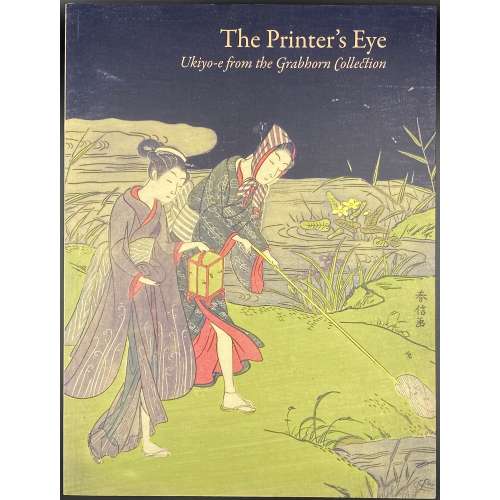 Softcover, pictorial wrappers, pp.: 1-200, il.
Softcover, pictorial wrappers, pp.: 1-200, il.Foreword: A treasure trove of ukiyo-e prints / Kobayashi Tadashi The Grabhorn ukiyo-e collection at the Asian Art Museum / Melissa M. Rinne Edwin Grabhorn : passionate printer and print collector / Julia Meech Figures of humans and animals : some early Japanese color prints from the Grabhorn Collection / David Waterhouse. Edwin Grabhorn (1889—1968), co-founder of the Grabhorn Press, Northern California's premier letterpress printer, was a pioneer American collector of Japanese prints. The Grabhorn prints in the collection of the Asian Art Museum comprise the upper echelons of the original collection. The collection includes a superb selection of early monochrome and hand-colored ukiyo-e prints by Sugimura Jihei, Torii Kiyonobu, Okumura Masanobu and others, from the seminal decades of the woodblock print production in the late 1600s and early 1700s.
-
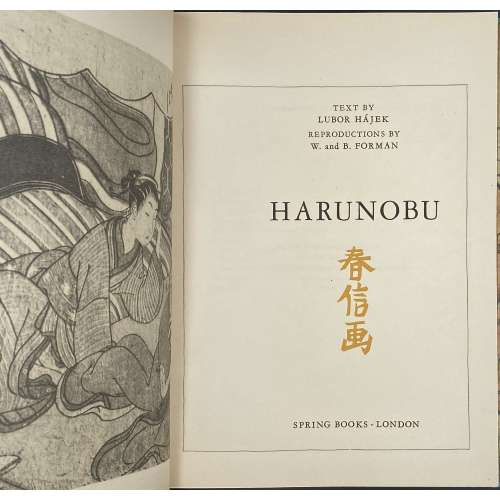 Japanese binding, 2 leaves of pictorial wrappers, [10] 11-63, 10 b/w plates, 63 colour plates within pagination; in a green cloth folder with gilt lettering to front and spine.
Japanese binding, 2 leaves of pictorial wrappers, [10] 11-63, 10 b/w plates, 63 colour plates within pagination; in a green cloth folder with gilt lettering to front and spine. -
 Artist: Utagawa Kunisada [歌川 国貞], a.k.a. Utagawa Toyokuni III [三代 歌川 豊国] (Japanese, 1786 – 1865). Signed: Toyokuni ga [豊国 画] in a red toshidama cartouche Block carver: Yokokawa Takejirō [横川竹二郎] (Japanese, fl. 1845 – 1863), seal: 彫竹 – hori Take. Publisher: Ibaya Senzaburō [伊場屋仙三郎] (Japanese, fl. c. 1845 – 1847). Media: Untrimmed fan print (uchiwa-e), 232 x 300 mm. Title: Tamagiku [玉菜]. Series: Chronicles of Elegant Women [風雅女史傳] (Fūga joshiden). Combined date seal and kiwame censor seal: Ansei 6 (1859). Other prints from the same series in this collection [SVJP-0216.2016] — Princess Sotoori:
Artist: Utagawa Kunisada [歌川 国貞], a.k.a. Utagawa Toyokuni III [三代 歌川 豊国] (Japanese, 1786 – 1865). Signed: Toyokuni ga [豊国 画] in a red toshidama cartouche Block carver: Yokokawa Takejirō [横川竹二郎] (Japanese, fl. 1845 – 1863), seal: 彫竹 – hori Take. Publisher: Ibaya Senzaburō [伊場屋仙三郎] (Japanese, fl. c. 1845 – 1847). Media: Untrimmed fan print (uchiwa-e), 232 x 300 mm. Title: Tamagiku [玉菜]. Series: Chronicles of Elegant Women [風雅女史傳] (Fūga joshiden). Combined date seal and kiwame censor seal: Ansei 6 (1859). Other prints from the same series in this collection [SVJP-0216.2016] — Princess Sotoori: SVJP-0400.2023 — Saiko:
SVJP-0400.2023 — Saiko:
 Note by Elena Varshavsky:
Tamagiku [玉菜] (Japanese, 1702 – 1726) – Precious Chrysanthemum (translated also as Jade Chrysanthemum; one can say also Gem Chrysanthemum). She was a courtesan famous for her beauty, kind heart, and countless artistic accomplishments. She died young and was deeply grieved by the establishment of Nakamanji-ya (中万字屋) for which she worked, and beyond. Her memory was celebrated during the Bon festival of the commemoration of the dead, and lanterns were hung at the gallery of that establishment and other neighbouring ones to commemorate her and appease her soul. These lanterns are seen behind her. Kabuki plays were continuously dedicated to her, she figured in Edo period literature and was often portrayed on ukiyo-e prints. In many cases, she was shown with the lanterns associated with her. Those lanterns were called “Tamagiku Lanterns”.
Other depictions of Tamagiku:
Note by Elena Varshavsky:
Tamagiku [玉菜] (Japanese, 1702 – 1726) – Precious Chrysanthemum (translated also as Jade Chrysanthemum; one can say also Gem Chrysanthemum). She was a courtesan famous for her beauty, kind heart, and countless artistic accomplishments. She died young and was deeply grieved by the establishment of Nakamanji-ya (中万字屋) for which she worked, and beyond. Her memory was celebrated during the Bon festival of the commemoration of the dead, and lanterns were hung at the gallery of that establishment and other neighbouring ones to commemorate her and appease her soul. These lanterns are seen behind her. Kabuki plays were continuously dedicated to her, she figured in Edo period literature and was often portrayed on ukiyo-e prints. In many cases, she was shown with the lanterns associated with her. Those lanterns were called “Tamagiku Lanterns”.
Other depictions of Tamagiku:

Tamagiku (Ancient and modern women's biography) by Kunisada, 1859.

Courtesan Tamagiku by Kunichika.

Tamagiku of the Nakamanjiya, Inaki Shinnojō, and Nakamanjiya Yahei (looking through the window) by Kunisada.

Nakamanji-Ya Tamagiku by Kunisada
Sources: darumapedia; kajiipeta; kabuki21; crosseyedgallery.
Nakamanji-Ya Tamagiku by Kunisada, 1857


